Prolapse or nephroptosis of the kidney is a disease characterized by increased organ mobility. A “wandering” kidney can move to the abdomen or pelvis and rotate around the vessel adjacent to it. Nephroptosis is the prolapse of the kidney of a patient in an upright position by more than 2 cm (at the moment of inspiration - up to 5 cm). Most often, pathology of the right kidney is recorded.
In the first stage of the development of the disease, the displacement of the kidney can be felt with the hand - when inhaling, this is done through the abdominal wall, and when exhaling, it takes a position in the subcostal space. At the second stage, in a standing person, the kidney comes out from under the ribs, and when he takes a horizontal position, it returns to its original place. With such movements, the kidney tends to wrap around its stem and a deficiency of its blood supply occurs. The third stage involves uncontrolled movement of the kidney.
Nephroptosis can develop into the cause of hydronephrosis, pyelonephritis, urolithiasis, as well as renal colic, arterial hypertension, miscarriages and other ailments. During adhesive processes, it is possible for the kidney to be fixed in the wrong position - fixed nephroptosis occurs.
General information about the disease
The kidneys have a certain degree of natural mobility: during physical activity or during breathing, physiological displacement of the organs occurs at a distance not exceeding the size of a vertebra in the lumbar region. If the vertical displacement of the kidney exceeds 2 cm at rest and 3-5 cm with effort, the patient is diagnosed with nephroptosis .
Anatomical features of the urinary system:
- the left kidney is usually located 2 cm higher than the right;
- in children, the normal position of the kidneys is observed by the age of 8-10 years, before this age organ prolapse is observed;
- in the anatomical bed, the kidney is supported by fascia and ligaments, as well as surrounding fatty tissue;
- Women are more prone to nephroptosis than men and are more likely to suffer from right-sided displacement.
Causes of nephroptosis
Nephroptosis is not a congenital disease, unlike dystopia. Prerequisites for the development of nephroptosis may be:
- problems with the ligamentous apparatus that fixes the kidneys in the desired position;
- pathological changes in perinephric fascial and fatty tissues;
- incorrect location of the renal vessels;
- reduction in the volume of the fat capsule of the organ.
Additional factors contributing to renal hypermobility:
- increased physical activity when doing strength sports;
- professions related to lifting heavy loads;
- decreased muscle tone of the abdominal wall;
- rapid rate of weight loss during emergency weight loss.
Thus, the risk group for nephroptosis includes drivers, loaders, operating surgeons, hairdressers (long standing position), patients with hypermobile joints, suffering from viscerosis, myopia, problems with connective tissue, and adolescents with asthenic physique during the period of active growth.
, nephroptosis of the right or left kidney may also develop .
Numerous pregnancies in women and bearing a large fetus also contribute to the displacement of the kidney.
Degrees of nephroptosis
Today in urology there are three degrees of nephroptosis depending on the degree of displacement of the kidney from its normal position.
- Degree I is characterized by the lower renal pole moving down a distance of one and a half lumbar vertebrae.
- Stage II is diagnosed when the lower pole descends onto two lumbar vertebrae.
- Grade III is assigned to nephroptosis when the lower pole of the kidney is displaced by more than three vertebrae.
The higher the degree of pathology, the more pronounced the signs of the disease.
Our doctors
Perepechay Dmitry Leonidovich
Urologist, Candidate of Medical Sciences, doctor of the highest category
40 years of experience
Make an appointment
Mukhin Vitaly Borisovich
Urologist, Head of the Department of Urology, Candidate of Medical Sciences
34 years of experience
Make an appointment
Khromov Danil Vladimirovich
Urologist, Candidate of Medical Sciences, doctor of the highest category
35 years of experience
Make an appointment
Kochetov Sergey Anatolievich
Urologist, Candidate of Medical Sciences, doctor of the highest category
34 years of experience
Make an appointment
Symptoms of nephroptosis
With grade 1 nephroptosis, the patient may experience pain in the lumbar region, heaviness in the abdominal cavity, and a feeling of discomfort in an upright position. When palpating the abdomen, the kidney is palpated while inhaling: when exhaling, the organ goes into the hypochondrium.
At the stage of moderate severity, when the patient is standing or sitting, the kidney completely falls below the subcostal region, but can be manually returned to its place. The pain syndrome is more pronounced, but after reduction it does not bother me.
A severe form of nephroptosis (grade 3) is indicated by severe pain that does not stop even in a supine position. In this case, the kidney occupies a position below the border of the ribs. In the most difficult case, the patient suffers from renal colic, dyspeptic symptoms, arterial hypertension, and increased nervousness.
Intense pain is associated with possible kinks of the ureter and kidney vessels, stagnation of urine, and excessive tension on the nerves. Clamping of the renal vessels without correction provokes renal ischemia. Patients complain of chronic pelvic pain.
From the nervous system the following are observed:
- loss of strength and irritability;
- headache and/or dizziness;
- heart rhythm disturbances;
- insomnia.
From the digestive system, the manifestations are as follows:
- nausea;
- bowel disorders;
- heaviness in the pit of the stomach;
- loss of appetite.
A general urine test determines:
- presence of blood cells;
- presence of protein;
- purulent inclusions (a sign of an additional infection).
Questions about the article
Elena, 38
October 13, 2021 at 07:31 pm
Hello. My story began in March of this year... after the usual flu, I still have a temperature of 37-37.2-37.4, I’ve been running around hospitals for more than half a year, I no longer have the strength. An ultrasound of the abdominal cavity revealed nephroptosis on the right side, grade 2-3. Tell me how scary this is, what should I do about it first. And could this be the cause of long-term low-grade fever?
drrotov
October 14, 2021 at 06:54 pm
Nephroptosis will not cause an increase in body temperature, but may cause pain in the area of the right kidney. For a more accurate assessment of the stage of nephroptosis, I would advise doing excretory urography in a lying and standing position. Based on the results of this study, it will be possible to talk about the need for treatment or surgery.
Complications
A common complication is the inflammatory process due to impaired urine flow. Intensive growth of bacterial microflora leads to pyelonephritis and cystitis. The patient complains of pain when urinating and increased urge. During infection, the body temperature may rise, the urine becomes cloudy and acquires an atypical odor. Urostasis threatens the formation of kidney stones and the development of hydronephrosis.
Prolonged kinks and stretching of blood vessels are fraught with increased blood pressure and hypertensive crises. Nephrogenic hypertension is diagnosed when pressure readings reach 280/160 mmHg. Art. You should be wary of torsion of veins and arteries, which leads to difficulty in the outflow of blood and lymph (lymphostasis). If both organs are displaced, kidney failure rapidly develops. Due to decreased kidney function, the patient experiences swelling, fatigue, apathy, and headaches. In the future, the doctor may prescribe hemodialysis or an organ transplant.
neroptosis kidney photo
Surveys
The diagnosis of nephroptosis is made on the basis of:
- complaints from the patient himself;
- palpation through the abdominal wall in vertical and horizontal positions;
- measuring pressure and observing its dynamics;
- results of functional and laboratory studies.
The most informative methods for detecting renal prolapse
- Ultrasound. The study is carried out in the standing and lying positions of the patient. Ultrasound determines the current position of the kidneys, size, presence of changes in tissues and foci of inflammation, and the state of the pyelocaliceal complex. Connecting Doppler ultrasound allows you to visualize blood vessels, assess blood flow and the degree of pathology.
- Excretory urography reveals the degree of displacement of the organ relative to the spine and the nature of the rotation of the kidney. For better information, it is not X-rays that are used, but computer (CT, MSCT) or magnetic resonance imaging.
- Scintigraphic study. Kidney function and urinary conduction disorders are detected by dynamic radioisotope nephroscintigraphy.
In addition to examining the urinary system, the nephrologist may refer the patient for gastroscopy, colonoscopy, or x-ray of the stomach to monitor the condition of the gastrointestinal tract, since bilateral nephroptosis causes splanchnoptosis (displacement of the abdominal organs).
Our services
The administration of CELT JSC regularly updates the price list posted on the clinic’s website. However, in order to avoid possible misunderstandings, we ask you to clarify the cost of services by phone: +7
| Service name | Price in rubles |
| Ultrasound of the kidneys and adrenal glands | 2 700 |
| Urography intravenous | 6 000 |
| Laparoscopic nephropexy | 100 000 — 135 000 |
All services
Make an appointment through the application or by calling +7 +7 We work every day:
- Monday—Friday: 8.00—20.00
- Saturday: 8.00–18.00
- Sunday is a day off
The nearest metro and MCC stations to the clinic:
- Highway of Enthusiasts or Perovo
- Partisan
- Enthusiast Highway
Driving directions
Treatment
In mild cases, the doctor may limit himself to a conservative method. In this case, the patient is shown:
- wearing a bandage;
- abdominal muscle massage;
- physical therapy to work on the muscles of the back and abdomen;
- rehabilitation treatment in a sanatorium;
- gentle regime without physical activity;
- balanced diet.
Developed forms (II and III degrees) of nephroptosis with the addition of infection, impaired hemo- and urodynamics, surges in blood pressure and other complications are corrected through surgery. Nephropexy involves restoring the position of the kidney in the anatomical bed and fixing this position in the surrounding tissues. After the intervention, it is necessary to lie on the bed with the leg part elevated to stabilize the correct position of the organ. Absolute contraindications to surgery are:
- displacement of internal organs;
- development of severe complications;
- advanced age of the patient.
Kidney prolapse
- Hmm... - I look at the pictures and understand that neither physical therapy nor wearing a special bandage will help here. The kidney is lowered to the height of three vertebrae, its lower third in a standing position is already in the pelvis. - You know, I recommend you surgical intervention. “I knew that this would all end,” the patient says somehow doomedly, “just like my aunt.” - My aunt has? - Yes... My mother’s sister also had a prolapsed kidney. She had surgery. This became the nightmare of her life. After the operation, she lay in bed for thirty days and was in terrible pain. Because of the scar, she divorced her husband. 15 years after the operation, she developed a hernia at the site of the scar, which was operated on 7 times. I don't want surgery. - Well, or you don’t want the same operation, right? - Yes. It’s better for me to take pills all my life than to suffer later like my aunt. — You see, now kidney prolapse is practically not operated on in the open way. There is also laparoscopic surgery. Instead of a large incision, there are three punctures, each of which is no more than 5 mm in diameter. — I thought laparoscopy was when the ovaries are looked at. - Not only that. A very large number of operations are now performed laparoscopically. A number of operations are performed only in this way. For example, lifting and fixing a kidney during nephroptosis. — How do you understand “kidney fixation”? — Well, a special mesh is placed under the kidney. It is attached in such a way that the kidney seems to hang in a hammock. The mesh supports the kidney and prevents it from falling below the physiological level. The outflow of urine is normalized, accordingly, urine does not linger in the pelvis, bacteria do not have time to multiply and pyelonephritis stops. The artery returns to its normal position, its diameter returns to normal, and blood pressure problems go away. - What about the scars? Well, after the operation there are still scars? And how long will I stay in the hospital? “In six months you will look for them and won’t find them.” Lie for 2-3 days. Maximum. — And then this mesh must be removed? - No. It remains in the body for life. - And I won’t feel it? - Of course not. You don’t feel, for example, a filling in a tooth. - Doctor, tell me... Will I be able to give birth? - Certainly. Problems with pyelonephritis and blood pressure will go away - there are no other contraindications. - And... - The patient looks away embarrassedly, - Will I be able to jump with a parachute? This is my dream. It’s stupid, of course, but what if this mesh comes off? - Well, what's stupid about that? A month after the operation, a powerful connective tissue capsule forms around the kidney - an almost natural supporting apparatus for the kidney. Jump as much as you want.
Prognosis and treatment of nephroptosis
Competent treatment of nephroptosis , including surgery, helps normalize blood pressure and relieve pain. However, advanced cases lead to chronic pyelonephritis or hydronephrosis. After nephroptosis is detected, the patient should refuse standing work and increased physical activity.
Prevention is based on:
- prevention of scoliosis in childhood;
- regular exercise with moderate effort;
- smooth weight loss if necessary;
- the use of prenatal corrective belts and bandages during pregnancy;
- timely contact a nephrologist for lower back pain in an upright position;
- regular medical examinations.
Prevention of nephroptosis
1 Nephrology in MedicCity
2 Nephrology in MedicCity
3 Nephrology in MedicCity
To prevent nephroptosis and other kidney diseases, regular consultations with a specialist are necessary. This is especially true for people who have suddenly lost weight and those who have injuries to the abdominal and lower back areas. Women after pregnancy and childbirth are recommended to perform exercises to strengthen their abdominal muscles.







